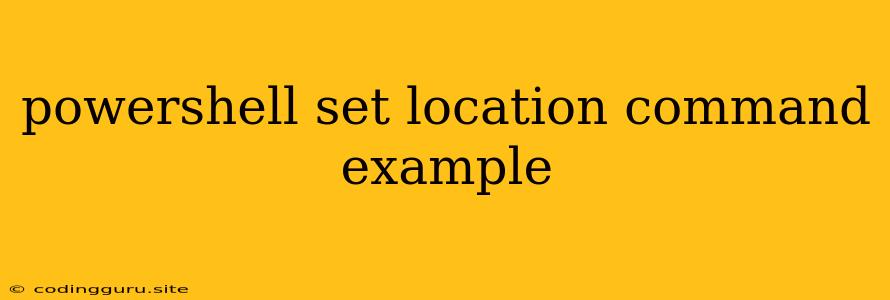Navigating Your PowerShell Environment: Mastering the Set-Location Command
PowerShell is a powerful tool for automating tasks and managing your system, and a key component of that power lies in your ability to navigate the filesystem efficiently. This is where the Set-Location command shines. It allows you to quickly change your current working directory, saving you precious time and reducing the potential for errors.
Let's explore the Set-Location command in detail, understand its various uses, and learn how to effectively leverage it in your PowerShell scripts.
What is the Set-Location Command?
The Set-Location command, often abbreviated as cd (short for "change directory") is a fundamental command used to modify your current working directory within PowerShell. In simple terms, it lets you move around your computer's file system. Think of it as a command that moves your "focus" from one folder to another.
Basic Usage of Set-Location
The simplest way to use Set-Location is to specify the new directory you want to navigate to. For example:
Set-Location C:\Users\YourUsername\Documents
This command will change your current working directory to the "Documents" folder located in your user profile.
Example Scenario: Moving to a Specific Folder
Let's imagine you're working on a project in the "MyProject" folder located within your "Documents" directory. You can use Set-Location to directly move to that folder:
Set-Location C:\Users\YourUsername\Documents\MyProject
Now, your PowerShell prompt will reflect your new location, indicating that you are currently in the "MyProject" folder.
Exploring the Current Location
To check your current location, simply use the Get-Location command, which conveniently returns your current directory path:
Get-Location
This command is useful for confirming your current position within the file system.
Using Relative Paths
For more flexibility, Set-Location allows you to use relative paths. Relative paths refer to directories relative to your current location. For example:
Set-Location .\MySubfolder
This command will navigate to a folder named "MySubfolder" located within your current directory. The dot (.) represents the current directory.
Moving Up a Directory Level
Sometimes, you need to move back up a directory level. You can accomplish this using the ".." notation:
Set-Location ..
This command will take you one level up in the directory hierarchy.
The cd Alias
For even faster navigation, PowerShell provides an alias for Set-Location - the familiar cd command. You can use cd interchangeably with Set-Location for more concise commands.
Example: Using cd for Quick Navigation
Let's say you're in the root directory (C:) and want to move to "Program Files":
cd Program Files
This single command will instantly move you to the "Program Files" folder.
Beyond Basic Navigation: Additional Features
The Set-Location command offers advanced features for enhanced control over your PowerShell navigation. Here are a few examples:
Using Variables:
You can store directory paths in variables for easy reference and reuse in your scripts:
$MyProjectPath = "C:\Users\YourUsername\Documents\MyProject"
Set-Location $MyProjectPath
Using the -Path Parameter:
The -Path parameter provides a more explicit way to specify the target directory:
Set-Location -Path C:\Temp
Combining Set-Location with Other Commands:
Set-Location can be integrated with other PowerShell commands to achieve complex tasks. For example, you can use it in conjunction with Get-ChildItem to list files within a specific directory:
Set-Location C:\Temp
Get-ChildItem
This will display a list of files and folders within the "Temp" directory.
Key Considerations
- Understanding Your Paths: Always be mindful of the directories you're navigating to and ensure you have the necessary permissions.
- Relative vs. Absolute Paths: Choose the path format that best suits your specific needs.
- Flexibility: Utilize variables and the
-Pathparameter to make your scripts more dynamic and readable.
Conclusion
Mastering the Set-Location command is crucial for efficient and effective use of PowerShell. By leveraging its features and understanding its nuances, you can navigate your filesystem with ease, streamline your scripting workflows, and ultimately achieve greater productivity. So, take advantage of the power of Set-Location and explore the vast possibilities of PowerShell!
